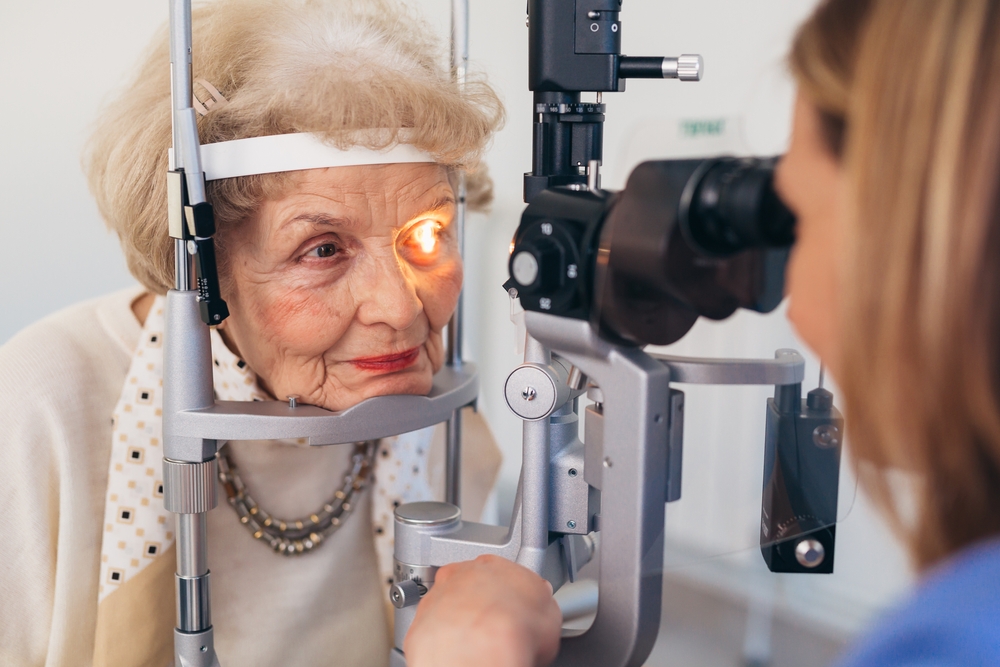Blog post by: Eye Physicians of Long Beach

Glaucoma is the leading cause of permanent blindness in the world. While anyone can develop glaucoma, some people are more at risk than others.
Glaucoma is a silent eye condition that sneaks in and causes vision loss. Fortunately, you may avoid complete vision loss and blindness by receiving a timely diagnosis and treatment.
Keep reading to learn more about glaucoma and what it means for your vision.

What is Glaucoma?
Glaucoma is a group of eye conditions that cause high eye pressure and destroy the optic nerve. The optic nerve is a critical part of your vision.
It sends visual information from the retina to the brain, which enables you to see. Damage to your optic nerve is permanent.
It can lead to irreversible vision loss or blindness without prompt treatment. Most people develop glaucoma in both eyes, but it’s typically worse in one eye.
What are the Causes and Risk Factors of Glaucoma?
The leading cause of glaucoma is high eye pressure or intraocular pressure (IOP). Abnormally high eye pressure can lead to the gradual degeneration of the optic nerve.
However, that’s not always the case. Some people develop glaucoma even when their eye pressure is normal.
The following risk factors can also increase your chances of developing glaucoma:
- Being over 40 years old
- Past eye injuries
- Previous eye procedures
- Family history of glaucoma
- Prolonged use of steroid medications
- Corneas that are very thin at the center
- Extreme nearsightedness or farsightedness
- Being of Hispanic, African American, or Asian heritage
- Health conditions like diabetes, high blood pressure, migraines, and sickle cell anemia
How Does Glaucoma Cause Vision Loss and Blindness?
Your eye is constantly making a clear fluid called aqueous humor. This fluid nourishes your eye.
It also helps your eye maintain its shape. As the aqueous humor fills the eye, the same amount flows through the drainage angle to maintain eye pressure. The drainage angle is found where the iris (colored part of the eye) meets the sclera (the white of the eye).
If the drainage angle gets blocked or your eye produces too much fluid, the fluid builds up. When fluid builds up, it increases your intraocular pressure.
As your eye pressure rises, it destroys the optic nerve and its ability to function. The optic nerve is a cable of millions of tiny nerve fibers.
Damage to these fibers can result in blind spots in your vision. These spots usually go unnoticed until they increase in size and affect more of your sight.
By the time you notice vision loss from glaucoma, the eye condition is often at an advanced stage. Damage to all the nerve fibers leads to blindness.
Types of Glaucoma
There are different types of glaucoma, including:
Open-Angle Glaucoma
Open-angle is the most common type of glaucoma. It occurs when the aqueous humor doesn’t drain as it should.
Open-angle glaucoma can also happen when your eye produces excessive fluid, causing it to accumulate. In both cases, the aqueous humor drains more slowly.
The aqueous humor not draining as quickly as it should causes a buildup of fluid that elevates your intraocular pressure, damaging the optic nerve. Open-angle glaucoma happens gradually, slowly taking away your sight.
It often has no noticeable symptoms in the early stages. Many patients have the early stages of open-angle glaucoma without realizing it first. If you experience any symptoms, it’s usually during the later stages of the eye condition.
Early on, your peripheral or side vision is affected. You likely won’t realize it’s happening. Later, you may find seeing objects and people in your central vision challenging.
Angle-Closure Glaucoma
Angle-closure or closed-angle glaucoma is less common but the most severe type of glaucoma. It occurs when your eye drains incorrectly because the drainage angle is too narrow or entirely cut off.
Consequently, the fluid backup rapidly increases your eye pressure, causing vision loss in a matter of hours or days.
Angle-closure glaucoma can steal your eyesight very quickly and is considered a medical emergency.
Without prompt treatment, vision loss is permanent and may lead to blindness. The symptoms of angle-closure glaucoma come on very fast and can include:
- Abrupt blurred vision
- Redness
- Intense eye pain
- Decreased vision
- Severe headache
- Halos around lights
- Nausea and vomiting
- Sudden vision loss
If you experience these symptoms, head to the emergency room or contact your eye doctor at Eye Physicians of Long Beach immediately to avoid losing your vision.
How to Prevent Vision Loss from Glaucoma

It’s estimated that half of the people with glaucoma don’t even know they have it. That’s because, most of the time, it causes no apparent symptoms.
The best defense against glaucoma is regular eye exams. Frequent dilated eye exams will allow your ophthalmologist to check the back of your eye and detect glaucoma early.
A timely glaucoma diagnosis is essential in reducing its impact. If you receive a glaucoma diagnosis, different treatment options can successfully manage the eye condition.
Treatment can slow or even halt the progression of glaucoma. However, there is currently no cure for glaucoma, and any vision loss due to it is irreversible.
The goal of glaucoma treatment is to bring your eye pressure down. Lowering your intraocular pressure slows or prevents further damage to the optic nerve and preserves your remaining sight.
One of the best ways to do this for mild cases of glaucoma is with special eye drops that work to lower your intraocular pressure. For these eye drops to work, they must be applied exactly as prescribed.
More advanced stages of glaucoma are treated with laser surgeries, traditional surgeries, or minimally invasive glaucoma surgeries (MIGS).
Can You Prevent Glaucoma?
There’s no way to prevent glaucoma. However, the following steps can help reduce your risk of glaucoma while improving your health:

- Schedule frequent eye exams to receive an early diagnosis if you have glaucoma
- See your ophthalmologist more often if you’re at risk for glaucoma
- Maintain a healthy weight
- Get your blood sugar under control
- Exercise in moderation to lower your eye pressure
- Eat plenty of colored fruits and leafy greens daily
- Notify your doctor about any steroid medications you’re taking
- Wear polarized sunglasses and a wide-brimmed hat whenever you go out to protect your eyes from the sun
- Ensure your teeth are clean by brushing them twice a day, flossing daily, and making routine visits to your dentist
- Inform your ophthalmologist if you’re taking blood pressure medication
- Wear proper eye protection while playing sports, doing home improvement projects, and any other activity that can cause eye injuries
Stop Glaucoma Before It Can Steal Your Sight
The best way to beat glaucoma and protect your vision is to have regular eye exams at Eye Physicians of Long Beach. If you can’t remember the last time you scheduled an eye exam, it may be a sign to have one.
Schedule yours at Eye Physicians of Long Beach in Long Beach, CA, to prioritize your eyes!
